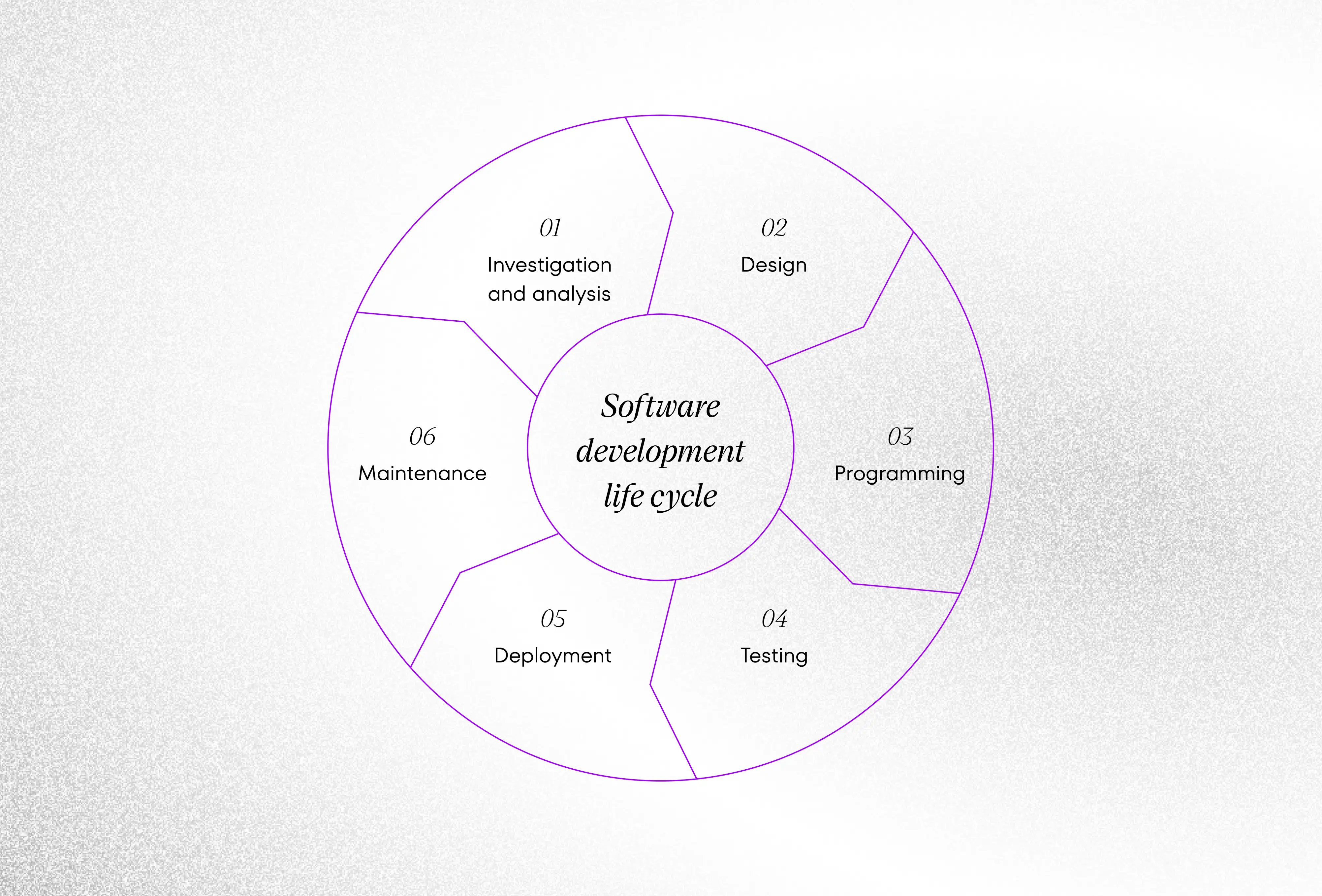November 14th, 2020 | by CSHARK
Software Development Life Cycle Models

Table of contents
Software development is a challenge. The complexity of tasks is overwhelming. To make the development process fast and effective, programmers had agreed to follow some procedures. SDLC model has become a framework to follow.
Software development life cycle (SDLC) – what is it?
Answering the question, it is a programmatic guide for software building. It’s a formal process with a detailed plan and phases that allows for tackling complex software projects. The most recognized phases include the investigation and analysis phase, analysis design, building phase, testing and deployment phase, and maintenance phase. Some authors add the project evaluation as the final phase.
Software development life cycle models and methods
- The waterfall model is sequential and focused on extended planning. The waterfall approach goal is to guide large projects to predictable results and a successful end.
- The agile model, such as Scrum quickly delivers a working software product. This model is ideal for rapid changes in the code.
- The dynamic system development method and the iterative model and the incremental model starts with a limited project scope. The product is expanded and improved by multiple iterations.
- There are other models like the V-shaped model (also known as the V model), verification and validation model or the Spiral model but in most cases, the Scrum method and agile model dominates them.
Waterfall model vs Scrum
Scrum framework is more dynamic than the waterfall model. Within a two-week sprint, a first working version of the software is deployed. When the last phase of the cycle is finished, we go back and the whole process starts all over again. The waterfall model requires that all functional descriptions are built in one go in three to nine months. It is a long-lasting formalized development process in which all requirements and functional descriptions are recorded in the special documents. Both, the waterfall model and Scrum methodology contain the SDLC phases.
SDLC model vs Project Life Cycle
SDLC model may be confused with Project Life Cycle framework. Both define projects with slightly different activities in focus. The first model is about meeting the requirements of the project. On the other hand, the second one covers all the pursuits of the software project.
Software development life cycle models phases
All software development frameworks consist of SDLC model phases. Some of them may be omitted in a single cycle or performed in a different order, but the main idea is pretty accurate.


Warning: Undefined array key “caption” in /var/www/cshark/releases/14/web/app/themes/cshark/template-parts/blocks/image-section/image-section.php on line 37
SDLC investigation and requirement analysis phase
The investigation phase is about establishing an organization’s objectives and discovering possible obstacles. Many crucial factors must be considered such as operational, financial, technical, and legal feasibility. ”Is it viable?” – the question resonates. If the answer is ”No!” then alternative solutions have to be proposed.
In this phase, the team breaks the system into pieces to analyze the situation. The pros and cons of upgrading a system (which is always a high risk) versus a brand new implementation of the software are carefully studied and presented to the management. When the scope of work and costs are agreed upon and the technical and business requirements are no longer an issue, it is time to move along to another phase.
SDLC design phase
At this phase, the desired features of the final product are fully described. That includes screen layouts, diagrams, and other documents. Product design teams might try different approaches to design in the most challenging areas of development.
As a result of prototype efforts and interviews, a set of design elements will be produced. They describe the desired features in diagrams such as screen layout, hierarchy, business process, and relationship with a data dictionary. At the end of the design stage, the new system is described as a collection of modules. It is a very important stage as the proper design has clearly defined foundations. In the end, a product that has a great design can increase user involvement. And that is our goal!
SDLC programming phase
Every system could be developed in one of two ways: by using the traditional approach to programming or object-oriented approach. In the traditional method, all phases must be completed in sequential order. The new phase begins when the previous phase is complete. The object-oriented approach assumes that the whole information system is a collection of objects that combine data and processes. This method is used to improve the quality and productivity of software development.
The team works in time-boxed sprints, developing software to a testable stage. They coordinate their efforts with business stakeholders to ensure that everything will be delivered as expected. In this stage, many things can go wrong. Sometimes the programmer has to go back, rethink coded solutions and add or change the code. And that is ok! The team tries to stick to the Statement of Work (SOW), write clean code, and end up with another high-quality software in the portfolio.
NEED A REMOTE SOFTWARE DEVELOPMENT TEAM?
FILL IN THE FORMSDLC testing phase
The code is tested at many levels. Modules are brought together to check them for code quality, integration, performance, and security. The goal of this phase is to remove errors, bugs, and ensure the smooth operation of the complete system.
Tests are differential. The types of testing performed depend on a system under development. There are many options available such as data testing, system testing, integration, black-box testing, white-box testing, regression, and user acceptance testing. The entire catalogue of software testing methods is larger, presented in detail in the testing methods article.
SDLC deployment phase
This is the most anticipated phase in which working software is released to production and finally, the final product is presented to the public. However, before the final product can be deployed, operational training needs to be completed by every end-user (user involvement is super important – he or she has to know how the product works!) and the development team responsible for supporting the system. After training is over software developers deliver the system to its final operation environment where it is used as intended.
SDLC maintenance phase
When the product is built and the previous phase is complete, the programming team looks after the application long after the release ensuring its flawless functioning and high quality of the product. If bugs are discovered in the post-launch phase, the software team addresses them instantly. In this phase changes and updates are made to the initial software. To avoid the high risk of failure during the implementation of changes in the code, the bugs are fixed up to date. Additionally, software teams prefer small projects than one big release with code changes. It has pros and cons but this solution is a lot safer.
A dictionary of useful SDLC models terms
System evaluation
Many people consider it to be the final phase. The goal here is to evaluate the entire development process. A long list of points needs to be checked such as meeting initial business objectives also reliability, functionality, and its effectiveness. If anything is imperfect, still could be improved.
Object-Oriented Analysis (OOA)
OOA is the process of analyzing a task to develop a model that supports completion. This process takes place in object-oriented software engineering. Object-Oriented Analysis is the first technical activity performed. The task is divided into several subtasks (domains) that represent different areas for example technological. The reason for dividing tasks is to be able to analyze each subtask separately. Implementation constraints are not considered. The result of the OOA process is a conceptual model that consists of a set of use cases, Unified Modeling Language, integration diagrams, class diagrams, and a UI mock-up. In object-oriented design, an output artifact that is not completely developed can still serve as input. Analysis and design may occur in parallel.
Systems Analysis and Design (SAD)
This is the process of creating information systems that use data, software and men skill to achieve a company’s business goal. It is a combination of analyzing and planning a new business system by defining its components and modules. SAD defines balance among competing requirements. It interacts with enterprise and business architecture. SAD outlines partitioning, interfaces, and deployment modelling. This high-level description is used to break down the system into components and modules. These elements can be designed and constructed separately and eventually integrated into the final system.
Life cycle
Objectives control
While executing projects it is important to set up control objectives. Managing them provides control over the results. Every project needs a work breakdown structure that schedules the work required to finish the entire project. The project manager establishes key areas in the work breakdown structure.
Work breakdown structure (WBS)
The work breakdown structure summarizes the major phases and milestones of the project development. It also contains an overview of the full scope and timeline. Milestones are described as tasks with a period of two weeks or more. Each task must be measurable with a defined output for example a document. A single work breakdown structure task may rely on one or more activities and contain coordinates with other tasks.
Baselines
Baselines end four phases of the SDLC. Each base is a milestone and plays a vital role in the iteration.
- functional baseline – ends conceptual design phase
- allocated baseline – ends preliminary design phase
- product baseline – ends the detail design and development phase
- updated product baseline – ends the production construction phase
Conclusion
All models including the waterfall model, spiral model, v shaped model, iterative and incremental model and agile model are the fundamental methods of creating software. It’s a process in application development that provides a framework for activities to ensure the good quality of the product. Each software development model is different and has its advantages and disadvantages. Which model is best for your situation depends on factors such as project size and its complexity, business requirements, production environment and budget issues. The app development based on SDLC consist of a detailed plan that describes how to build a particular software.
Knowing the SDLC models and working with them allows us to deal with large complex projects. CSHARK operates in accordance with the best practices in terms of software development including development models. This is one of the reasons why our client’s projects are successful.


